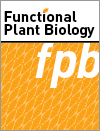
Functional Plant Biology
Volume 48 Number 9 2021
Genotypic variability in transpiration (Tr) response to vapour pressure deficit (VPD) exists in wheat (Triticum aestivum L.). The physiological mechanism governing the contrasting (Tr) response to VPD is debatable. The present study indicates that stomata mediate the Tr to VPD response in coordination with plant hydraulics.
The effect of UV-B radiation on biology received widespread attention in recent years. Zebrina pendula leaves could shield UV-B through a series of reactions to ensure normal physiological activities. Therefore, even under strong UV-B radiation, Z. pendula leaves could maintain normal growth.
Abiotic stresses can negatively affecting plant growth, development, and productivity, leading to low crop yield and quality. We report here the functional characterisation of OsLEA1a in transgenic rice and its overexpression enhance the tolerance of rice to diverse abiotic stresses by inhibiting cell membrane damage and enhancing reactive oxygen species scavenging capacity. These results show that OsLEA1a could be a useful candidate gene for engineering abiotic stress tolerance in cultivated plants.
FP20351The microbiomes on the roots of wheat (Triticum aestivum L.) and rice (Oryza sativa L.) exhibit significant differences in structure between root types and along root axes

Phylogenetic marker gene sequencing was used to investigate the spatial variation of microbial communities on wheat and rice roots. Microbial communities differed significantly between species, root types and position along the root axes. The magnitude of variation between different root types and along individual roots was comparable with the variation detected between different species. We argue that this variation should be measured more routinely to better link localised root–microbe interactions with root system design, plant health and performance.
FP20351 Abstract | FP20351 Full Text | FP20351PDF (2 MB) | FP20351Supplementary Material (196 KB) Open Access Article
FP21011Concurrent overexpression of amino acid permease AAP1(3a) and SUT1 sucrose transporter in pea resulted in increased seed number and changed cytokinin and protein levels
 , Annu Ninan, Natalia Cripps-Guazzone, Martin Shaw, Jiancheng Song, Ivan Petřík, Ondřej Novák, Mechthild Tegeder and Paula E. Jameson
, Annu Ninan, Natalia Cripps-Guazzone, Martin Shaw, Jiancheng Song, Ivan Petřík, Ondřej Novák, Mechthild Tegeder and Paula E. Jameson 
Legume seeds are important for global protein production and sustainable agriculture. Ensuring that nutrient transport to seeds and metabolic processes are operating at optimal capacities is an essential approach to the challenge of enhancing seed yield and maintaining seed quality. Simultaneously overexpressing a sucrose transporter and an amino acid transporter led to higher cotyledon sucrose at process pea harvest and increased seed number and protein content at maturity.
FP21011 Abstract | FP21011 Full Text | FP21011PDF (664 KB) | FP21011Supplementary Material (445 KB) Open Access Article
FP21079Seed nanopriming by silicon oxide improves drought stress alleviation potential in wheat plants
Seed treatment with silicon oxide nanoparticles promotes seedling growth. SiO2 nanopriming improves photosynthetic efficiency under drought stress. SiO2 nanopriming alleviates the oxidative stress to tolerate drought stress. An increase in biomass was observed in nanoprimed drought stressed plants.
In Arabidopsis thaliana (L.) Heynh., MYB59 transcription factor has been shown to regulate calcium homeostasis and is induced by cadmium excess. In populations of the facultative metallophyte Arabidopsis halleri ssp. halleri (L.) O’Kane and Al-Shehbaz characterised by different nutritional behaviours, MYB59 is differentially regulated under both calcium deficiency and exposure to cadmium. This suggests that MYB59 regulation is part of the complex network linking mineral nutrition and Cd tolerance/accumulation.
FP20396The association of leaf sulfur content with the leaf economics spectrum and plant adaptive strategies
Sulfur is an essential nutrient for plant growth, but few studies have investigated its stoichiometry in terrestrial ecosystems and its contribution to plant functioning remains unclear. We found evidence that leaf sulfur content is positively correlated with leaf nitrogen content and is mainly associated with faster-growing types of plants.
FP20292Transcriptional responses of Hypericum perforatum cells to Agrobacterium tumefaciens and differential gene expression in dark glands
 , Gregory Franklin and Alberto C. P. Dias
, Gregory Franklin and Alberto C. P. Dias
Hypericum perforatum L., known as St. John’s wort, is a medicinal plant with anti-depressant, anti-inflammatory and anti-cancer properties. H. perforatum is recalcitrant to transformation by Agrobacterium tumefaciens, which limits metabolic engineering studies. We explored the expression profiles of key genes involved in several plant defence responses to get insights into the molecular basis of this recalcitrance. Our results suggest that secondary metabolites could impair pathogen´s growth, making H. perforatum recalcitrant to A. tumefaciens-mediated transformation.
FP21017Genome wide identification and expression pattern analysis of the GRAS family in quinoa
Quinoa is suitable for growing in high-altitude areas and it is resistant to multiple abiotic stresses. GRAS is a fundamental transcription factor in plant growth and development. To date, systematic analysis of the GRAS gene family in quinoa has not yet been conducted. To accelerate the improvement of quinoa as a crop, this study provides valuable information for understanding the functions of GRAS genes in quinoa.




